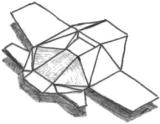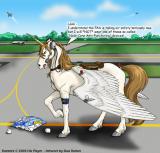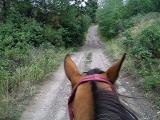I wanted to avoid making any craft that resembled Star Trek™ or any of the other dozen popular space shows, for that would generate the same friction encountered earlier with the Shuttlecraft.
However, since nearly every shape I can imagine has already been done, any goal of completely avoiding any resembling, is practically impossible.
Number Two:
 Enlarge Enlarge
Neat design. Not copyrighted by Hollywood. This is the starting point for Bluebird.
Because of my awareness for health issues, and sensitivity to electrical and magnetic fields, I first mandated that the engines be separate from the cabin, for the health of the crew.
I searched for a better name for the engine pods, but discovered that "nacelles" existed before Star Trek™, and are therefore acceptable names.
I did manage to avoid the round and square shapes typically seen, by making a trapezoid.
Is it aerodynamic?
Hey! Blunt noses improve shock wave separation from the nose, much like the Apollo capsule re-entry, so it's not an entirely off the wall idea.
Next, I added something to provide floating or hovering: counter-grav generators, and placed them on the wings, once again; away from the cabin.
Also, avoiding the name "anti-grav".
Whether these are turbo-fans for pushing air, or something else for manipulating gravity, I shall not say.
Also, when underwater ocean tiles become available, I expect this craft to maneuver underwater just as easily.
Visibility from the cockpit was another big concern, especially compared to a Runabout.
This model features a window with no obstructions, so that flying from the cockpit is finally a desirable position.
The last concern was the doors. One, two, or three leafs... Hinged or sliding... Once again, I choose the practical. We already have sliding doors at the supermarket, so I mixed and matched what fit for the space.
The sound effects I made, are basically the same pneumatic air-pressure design that already exists. Any resemblance to sound effects in movies, is unintentional, and basically a reflection of the physics involved.
This model package originally relied on three 3d instruments from the standard Flightgear base package installation, ai, alt-2, and yoke, and includes two other modified 3d instruments (clock and controls) that needed minor changes to the property or path to work with the ufo flight model.
The digital instruments (digital.rgb) were originally based on the KY196 comm panel, but have been redone from scratch for high-res readability like a glass-cockpit. This digital2 directory should be usable by anyone wishing to add digital instruments to their model.
|
 Enlarge
Enlarge
 Enlarge
Enlarge